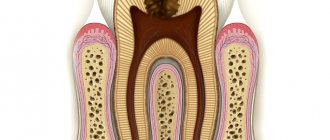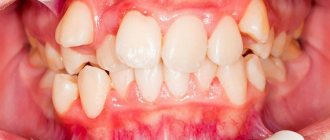Content:
- Classification of pathology
- Causes of the disease
- Symptoms of the disease
- Diagnostic measures
- How to treat
- What will happen if left untreated?
- What can you do to avoid getting sick?
A jaw cyst is a hollow benign formation localized in the jaw bone.
There is liquid content inside it. Very often, the structure develops unnoticed by a person for a long time and is accidentally discovered during an X-ray diagnosis for another reason. If a cyst in the jaw becomes inflamed, the patient immediately feels it. Suppuration can provoke the occurrence of periostitis, sinusitis, osteomyelitis, and fistula.
Unfortunately, most often the formation has to be removed surgically. The doctor performs a resection of the apex of the tooth root and at the same time fills the cavity cleared of exudate with a special biological composite composition.
The danger of a cyst and its treatment at home
Inflammation of a cyst under a tooth is not only fraught with destruction of the jawbone with the loss of one or more units. Purulent formation can cause chronic sinusitis, lymphadenitis, periostitis, osteomyelitis. Some complications (sepsis, meningitis) directly threaten life, so alarming symptoms should not be taken lightly. The formation may break through, but not resolve, so treatment is necessary. Even if the swelling on the gums is small, the condition should be assessed by a doctor.
Trying to get rid of a cystic capsule using traditional methods is a waste of time. Folk remedies (ointments, lotions, decoctions) can be used as auxiliary methods, but not the main therapy. They are able to reduce inflammation, calm the pain a little, but cannot eliminate the fibrous capsule with purulent contents.
Classification of pathology
Cysts localized in the tissues of the upper or lower row of teeth are very common. With their development, a cavity appears, the walls of which are covered with fibrous tissue, and the inner surface consists of an epithelial layer. The capsule holds clear or cloudy liquid.
Doctors distinguish the following types of pathology:
- Primordial. This is a cyst of the lower jaw. It appears in the area of the third molar. She has very thin fibrous walls. The inside of the capsule is lined with flat epithelium. According to its structure, the tumor may contain one or several small chambers.
- Follicular. Formed before tooth eruption. It can grow in the area of the alveolar margin. Includes cells that intensively produce viscous mucus. Because of this, the internal contents of the anomalous structure are quite viscous. A follicular formation is formed from the enamel organs of the unerupted unit. One or several teeth are found inside it. These may be formed crowns or tooth buds.
- Radicular. It occurs more often than others - in eighty percent of cases. Usually grows above the upper teeth. The diameter reaches from half to two centimeters. Often inflamed. Then the cells begin to hyperplasia, network-like processes are formed that extend into the thickness of the walls. The liquid contents of the radicular structures are rich in neutrophilic leukocytes. Often with this type of pathology, the patient develops sinusitis. This is due to the peculiarities of the localization of the inflammatory site.
- Retromolar. It is formed due to a long-term inflammatory process occurring in the thickness of the soft tissues. It is a consequence of complicated teething.
- Nasoalveolar. It occurs near the nasopalatine canal (the border between the upper row and the wing of the nose).
- Aneurysmal. Very rare in dental practice. Appears only on the lower jaw. This type of neoplasm is still poorly studied. It is known that there is blood or a red-pink liquid inside it. Many scientists agree that the symptoms of an aneurysmal cavity are a consequence of hormonal imbalance.
- Traumatic. Occurs due to recent facial trauma.
- Residual. The result of mistakes made by the doctor during tooth extraction, or the consequence of the patient ignoring the surgeon’s instructions.
The doctor decides how to treat a dental cyst, taking into account the cause of its development. It is very important to understand why the tumor occurred. If the root cause is not identified, the likelihood of relapse will remain high.
Causes of maxillary sinus cysts
Predisposing factors for the formation of a maxillary sinus cyst are:
- Individual anatomical and topographical features of the structure of the nasal cavity, which impede the free movement of air through the nasal canals (congenital deformities, deviated septum).
- Blockage of the excretory duct of the glands located in the mucous membrane of the paranasal sinus. This happens with frequent rhinitis, sinusitis, allergic rhinitis and polyposis.
- Inflammatory dental diseases with infection spreading to the root canals. The paranasal sinuses are separated from the roots of the molars and premolars by a thin septum, so infection from pulpitic or periodontitis teeth often causes an inflammatory process in the maxillary sinus.
- The formation of a dental cyst, which grows into the maxillary sinus and continues to grow inside it.
The maxillary cyst gradually grows larger, filling the sinus without pronounced clinical symptoms. The presence of a formation can be suspected during exacerbations caused by colds, acute respiratory viral infections, local hypothermia, and decreased immunity.
Causes of the disease
Already based on the classification, it becomes clear that tumors appear in the tissues of the oral cavity for a variety of reasons. Among the main provoking factors:
- Damage to hard dental tissues. Untreated caries, periodontitis, pulpitis are all diseases in which pathogenic agents penetrate the periodontium through unsealed root canals.
- Inflammation of the area adjacent to the area where the cyst is located. Quite often it turns out that a benign tumor formed after sinusitis or inflammation of the gums. This happens because the infection penetrates through the bloodstream into the bone tissue from the maxillary and nasal sinuses.
- Injuries, bruises, blows. The first time after them, a person may not notice anything. But later a nagging pain appears, indicating a problem.
Very rarely do doctors have to treat congenital cysts. It has not been established why they occur.
Eruption cysts
Eruption cysts are a type of soft tissue benign cysts associated with the eruption of primary or permanent teeth and appear before the appearance of these teeth in the oral cavity. This is a soft tissue analogue of retention cysts, but which belongs to a separate nosological unit.
Retention cysts develop around the crown of unerupted teeth embedded in the bone. Cutting cysts occur when the tooth has already begun to erupt through the soft tissue covering the bone.
The exact etiology of eruption cysts remains unclear. Agulio and others, in their retrospective studies, mention caries, trauma, infection, and lack of space for eruption as possible causative factors.
Despite the large number of theories of origin, cysts arise from the enamel epithelium of the tooth crown due to the accumulation of fluid or blood at the site of the follicle.
Analysis of the literature shows the infrequent occurrence of eruption cysts. Such data may be obtained due to the fact that many cysts appear and then disappear undetected, while dentists see only clinically manifested pathologies. Anderson reports 54 histologically confirmed cases over the past 16 years. Agulio data - 36 cases retrospectively analyzed over 15 years. Somewhat later, Bodner discovered the prevalence of eruption cysts in the form of 22% of all cystic formations of the upper jaw in 69 children. Bonder recently presented 24 new cases of eruption cysts in 2004.
Eruption cysts and hematomas usually occur in the first or second decade of life. Reports show that eruption cysts most often occur between the ages of 6 and 9 years, a period associated with the emergence of the first permanent molars and incisors.
Eruption cysts more often affect the right side than the left, and more often in men than women. However, Pinkham reports no gender predisposition.
Agulio in his study showed that 2.8% of eruption cysts occur in the incisor and molar areas, and 17.2% in the canines and premolars. Other scientists confirm the data presented, and explain the predominance of the incisor zone over the molar zone in a ratio of 2:1 by a better view of the anterior area.
Clinically, the disease appears as a rounded, fluctuating, often radiolucent swelling of the alveolar margin at the site of tooth eruption. In cases where the cavity surrounding the crown contains blood, the swelling appears purple or dark blue, hence the term eruption hemangioma. Differential diagnosis would include hemangioma, neonatal alveolar lymphangioma, pyogenic granuloma, amalgam staining.
On an x-ray, it is quite difficult to determine the cavity of an eruption cyst, because both the cyst and the tooth are located in the soft tissues of the alveolar process, and the bone remains unaffected, in contrast to a retention cyst, which looks like a well-contoured monocystic radiolucent crescent-shaped cavity above the crown of an unerupted tooth.
Histologically, this cyst has the same microscopic characteristics as a retention cyst: connective tissue covered with a thin layer of non-keratinizing epithelium.
Most of these cysts go away on their own and usually do not require special treatment. If the formation is painful, bleeding or infected, surgical excision is indicated to expose the tooth and drain the contents.
Description of clinical cases
We present two cases of eruption cysts in patients who sought treatment at our clinic.
Clinical case 1
The parents of an 8-year-old boy contacted the Department of Pediatric Dentistry with complaints of bluish swelling of the gums in the anterior segment of the upper jaw (Photo 1).
Figure 1: Preoperative photo showing an eruption cyst in area 21
The patient's parents were frightened, suggesting a malignant tumor. The medical history revealed that 61 were removed 1 year ago due to caries. The lesions began to appear 2 weeks ago as a radiolucent swelling on top of the normal mucosa, which slowly increased to its present size. The color of the mass has slowly changed from normal pink mucous to a true bluish-black color over the past week. No other changes or symptoms were observed. A general examination revealed no pathologies. There was no history of acute infections, trauma, or drug or food allergies. An examination of the oral cavity determined the child's mixed bite. All first permanent molars had already erupted; all but 21 incisors were in various stages of eruption. Carious lesions were found 52, 62, 73. Examination of the soft tissues of the oral cavity revealed no pathologies, with the exception of swelling in the area 21. Clinically, the gingival lesion looked like a bluish-black, round, fluctuating formation on the buccal side of the gums in the area of unerupted 21. The size of the swelling is approximately 1 ,5x2 cm, soft consistency. The overlying mucosa is smooth and without ulceration. X-ray examination confirmed the process of eruption 21 without pathological involvement of bone tissue or tooth. Clinically and radiologically, eruption cyst 21 was diagnosed.
The clinical situation was explained to the parents and advice was given to observe the swelling for the next 2 weeks, since the formation could resolve on its own without surgical intervention. The patient's appointment is scheduled in 15 days. The swelling remained, and a dull pain occurred when chewing. The meaning of the surgical procedure was explained to the parents and consent was obtained. Before the intervention, a blood test was performed. Treatment included excision of the eruption cyst and drainage of the contents. An incision was made 21 for easier cutting. Postoperative recommendations were given (Photo 2).
Photo 2: Cut made and exposure 21
The patient was observed a week later and normal eruption was observed.
Clinical case 2
An 8.5-year-old girl came to the clinic with complaints of a bluish-black discoloration of the gums, as well as swelling in the anterior segment of the upper jaw (Photo 3). Some change in sensitivity was also observed. The mass began to appear 2 months ago as a radiolucent swelling on top of the normal mucosa and slowly increased to its present size. There was a dull pain when chewing.
Figure 3: Preoperative photo showing eruption cyst in area 21
General physical health of the child without pathology. Examination of the oral cavity revealed a mixed bite. All but 21 permanent first molars and central incisors had erupted.
The dimensions of the swelling are approximately 2.5x2.5 cm. The consistency is soft and fluctuating. The overlying mucosa is smooth and without ulceration. X-ray examination confirmed that 21 was in the process of eruption without pathological involvement of the surrounding bone or tooth. Clinically and radiologically a diagnosis of eruption cyst 21 was made.
Surgical treatment was applied, the tooth was exposed. Subsequently, normal eruption was observed (Photo 4).
Photo 4: Cut made and exposure 21
Discussion
An eruption cyst is a soft tissue analogue of retention cysts, but is defined as a separate nosological unit. Clinically, an eruption cyst appears as a dome-shaped swelling on the mucous membrane of the alveolar margin, soft in consistency with a color ranging from blue, purple to blue-black.
During X-ray examination, it is quite difficult to determine the cystic cavity, since the cyst and tooth are located in the soft tissues of the alveolar ridge, without affecting the bone, which distinguishes an eruption cyst from a retention cyst, which is characterized by a clear monocystic radiolucent crescent-shaped zone near the crown of an unerupted tooth.
Histologically, this cyst has the same microscopic characteristics as a retention cyst: connective fibrous tissue with a thin layer of non-keratinizing epithelium.
Most eruption cysts do not require special treatment and disappear on their own. Surgery is necessary when there is pain, bleeding, infection or aesthetic problems. Treatment should be carried out to improve the child's quality of life. The high frequency of occurrence of such cysts, as well as localization in dynamically changing places, puts forward requirements for fairly conservative treatment in the population of young people. Surgery is not always indicated, as cysts may resolve on their own and be accompanied by normal tooth eruption. If this does not happen, simply excision of the roof of the cyst allows for faster eruption. Partial or complete excision of the underlying tissue and drainage of the cavity is indicated when eruption is inhibited or the cyst increases in size.
In case 1, a wait-and-see approach was adopted because the mass did not cause discomfort and the mass was expected to resolve on its own. But after 15 days, upon repeated treatment, the cyst continued to increase in size. Therefore, a decision was made to surgically excise and expose the crown.
In clinical case 2, excision of soft tissues followed by compression of the cyst was associated with a large size of the formation and a long duration of the disease. The swelling was observed for a long time, caused pain and gradually increased, so surgical tactics were immediately chosen.
New treatment technologies using Er, Cr-YSGG lasers have been proposed by Boj and other scientists. Advantages over standard techniques include no need for anesthesia, minimal bleeding during surgery and patient comfort. In clinical practice, the use of such equipment is limited by high cost and complexity.
Conclusion
Disturbances in the development of teeth can manifest themselves as anomalies in the form of various swellings of the mucous membrane, cysts of the eruption of temporary and permanent teeth in childhood. Eruption cysts are associated with erupting teeth and can vary in size, color, and morphology. Such formations can cause cancerophobia in children and their parents. Knowledge of this pathology among specialists is very important for making the correct diagnosis and choosing the appropriate treatment.
Authors: Preeti Dhawan, Gulsheen Kaur Kochhar, Sanjay Chachra, Shweta Advani
Symptoms of the disease
In the first days of development of the pathology, there are no subjective symptoms. But the larger the cyst becomes, the stronger and more vividly it declares itself. Then a kind of gumboil may form in the gum area. At first, the protrusion does not hurt during palpation and hardly bothers the patient.
On an orthopantomogram, the doctor observes a spherical cavity with clearly defined contours. On an x-ray, you can see the root of the affected tooth with inflamed periodontium.
In advanced cases, when a large amount of purulent mass accumulates inside the cavity, the patient experiences the same symptoms as with osteomyelitis. Then the tumor volume increases. The gums swell and become very painful. Periodically, a small hole appears in its wall through which pus is released.
How to treat
In most cases, cysts cannot be treated without surgery. Only in unadvanced cases is it possible to get rid of the tumor by opening it and draining it.
The operations performed for the disease are called cystectomy and cystotomy. They both involve removing the formation. But in the first case, it is removed completely, and in the second, only the front wall is excised.
The main goal of a dental surgeon is to preserve the tooth growing in the area where the tumor is located. Unfortunately, this is not always possible. So, if the tooth root is immersed in the cyst cavity by more than 60% of its length, emergency removal is indicated. Such a unit can no longer be functional. Soon after excision of the tumor, it will still become loose and fall out.
Therefore, it is very important not to start the disease. Considering that it may not manifest itself for a long time, it is important to undergo a specialized examination at the dental office every year. This will increase the chances of successful early diagnosis.
Treatment of a cyst without tooth extraction
The success of treatment directly depends on how early it was detected. Therefore, dentists recommend that patients undergo regular preventive examinations and seek help at the first signs of illness. More recently, therapy necessarily involved tooth extraction. Of course, this approach did not suit either the doctors or especially their patients. Today, dentists' methods have changed significantly, and it is possible to get rid of a cyst without losing the beauty of your smile.
Treatment of the cyst can be surgical or conservative. The choice of therapy method depends on: the type, age of the patient, personal wishes and is determined for each patient.
What will happen if left untreated?
Despite the fact that most patients do not have acute symptoms with the diagnosis described, the growth of the cavity can lead to very unpleasant and even dangerous consequences for health. This means:
- sepsis;
- phlegmon;
- premature loosening and loss of one or more teeth;
- inflammatory damage to the tissues of the periosteum;
- the formation of a malignant tumor due to cell degeneration;
- osteomyelitis;
- frequent occurrence of fistulas;
- high risk of fracture.
All these consequences are not harmless, which is why it is so important to detect pathology at the very beginning of its development.
What can you do to avoid getting sick?
You can reduce the likelihood of developing the disease by following simple rules:
- Brush your teeth twice a day. Use a high-quality brush and paste during hygiene procedures. Don't forget about the role of dental rinses and dental floss.
- Once a year, remove tartar in the dental office using an ultrasonic scaler. Professional hygiene is the best prevention of most dental ailments.
- Eat a balanced and healthy diet. Eat less sweets. Eat plenty of fresh fruits and vegetables.
- Check your dental health once a year. You need to visit a doctor, even if nothing bothers you.
- Always follow your dentist's instructions.
- Avoid traumatic injuries to the face. When engaging in potentially dangerous sports, always wear special protective equipment.
A jaw cyst is a dangerous tumor. Initially it is benign, but under certain conditions it can become malignant. Fortunately, this happens extremely rarely.
If the tumor grows very quickly, even a jaw fracture is possible. It shouldn't come to this. Treatment must be timely and competent.










